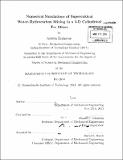Numerical simulations of supercritical water-hydrocarbon mixing in a 3-D cylindrical tee mixer
Author(s)
Raghavan, Ashwin, Ph. D. Massachusetts Institute of Technology
DownloadFull printable version (21.25Mb)
Other Contributors
Massachusetts Institute of Technology. Department of Mechanical Engineering.
Advisor
Ahmed F. Ghoniem.
Terms of use
Metadata
Show full item recordAbstract
Supercritical water upgrading and desulfurization (SCWUDS) is a new concept in the oil refining industry wherein, crude oil is mixed with supercritical water in a reactor leading to chemical breakdown of the sulfur containing compounds (desulfurization) and cracking of long chain hydrocarbons to shorter chain compounds closer to commercial fuel components (upgrading). The focus of the present work is the development of a numerical tool to investigate the mixing of water and hydrocarbons under supercritical fully-miscible conditions (water and hydrocarbon forming a single phase) in a realistic 3-D cylindrical tee mixer geometry so as to develop an understanding of the effects of geometry, flow rates and fluid properties on the mixing dynamics which in turn will influence the rate of thermal cracking reactions of hydrocarbons and organosulfur compounds as well as the final product distributions. This work includes a consistent treatment of near-critical thermodynamics and transport property variations of real fluid mixtures. A Peng-Robinson EoS with simple van der Waals mixing rules is employed to model the near-critical thermodynamic behavior, with the mixture binary interaction parameter obtained from a Predictive Peng-Robinson approach using a group contribution method (PPR78). A 2nd order accurate finite-volume methodology is used for the numerical solution of the conservation equations. The developed numerical tool was used to investigate the mixing of supercritical water and a model hydrocarbon (n-decane) in a small-scale cylindrical tee mixer (pipe ID = 2.4mm) under fully miscible conditions. For a Reynolds number at the water inlet of 500 and a [delta]T between the two streams of l00K (Tw,in = 800K, Td,in= 700K), the flow downstream of the mixing joint remained laminar. Most of the mixing and heat transport occurs due to the circulating action of a counter-rotating vortex pair (CVP) in the hydrocarbon jet formed due to the reorientation of the vorticity preexisting in the hydrocarbon stream flowing through the vertical pipe. This CVP gets progressively weaker as it is advected downstream, due to vorticity diffusion and species and heat transport is dominated by molecular diffusion over small length scales in the far downstream region. Consequently, the mixing rate plateaus in the far downstream region of the tee mixer. Near-critical property variations were found to have a negligible impact on the flow field and mixing behavior under these conditions. However, for a 300K temperature difference between the two streams (Tw,in = 1000K, Td,in = 700K), the water-HC shear layer becomes unstable and rolls up downstream of 5 diameter lengths from the mixing joint. The onset of instability in the shear layer also triggers the stretching and breakdown of the hydrocarbon jet CVP leading to a significant enhancement in mixing manifested as a jump in the mixing rate and a thickening of the mean mixing layer. However, water n-decane mixing under identical inlet conditions but with constant physical properties, showed a stable shear layer with the flow reaching steady state. For a large [delta]T between the streams of 300K, the strong density increase (due to cooling of the water component) and the strong viscosity decrease (due to heating of the n-decane component) leads to a local increase in the Re within the mixing layer, resulting in the instability of the shear layer. SCW n-decane mixing with [delta]T = l00K was also simulated for increasingly higher Reynolds numbers up to the transition to turbulence. When the Reynolds number at the water inlet is increased to 700, the shear layer between the water and n-decane streams is found to become unstable near x = 6D downstream of the mixing joint followed by the subsequent roll up of the shear layer. The local increase of Re within the mixing layer due to mechanisms similar to the [delta]T = 300K case was found to be the cause of the shear layer instability. At Rew,in = 800 the unsteady small scale flow structures in the mixing layer and the consequent flow field fluctuations due to them are much stronger. The stretching and breakdown of the CVP in this case, is accompanied by stronger streamwise vorticity enhancement resulting in much faster mixing compared to the case of Rew,in = 700.
Description
Thesis: S.M., Massachusetts Institute of Technology, Department of Mechanical Engineering, 2014. Cataloged from PDF version of thesis. Includes bibliographical references (pages 167-171).
Date issued
2014Department
Massachusetts Institute of Technology. Department of Mechanical EngineeringPublisher
Massachusetts Institute of Technology
Keywords
Mechanical Engineering.